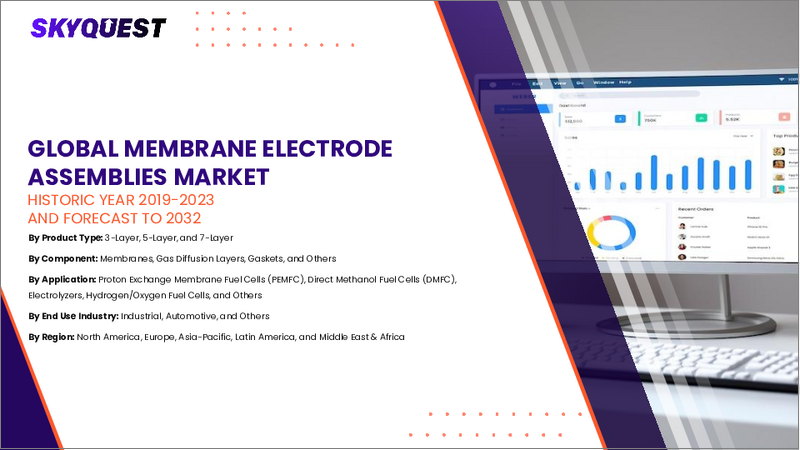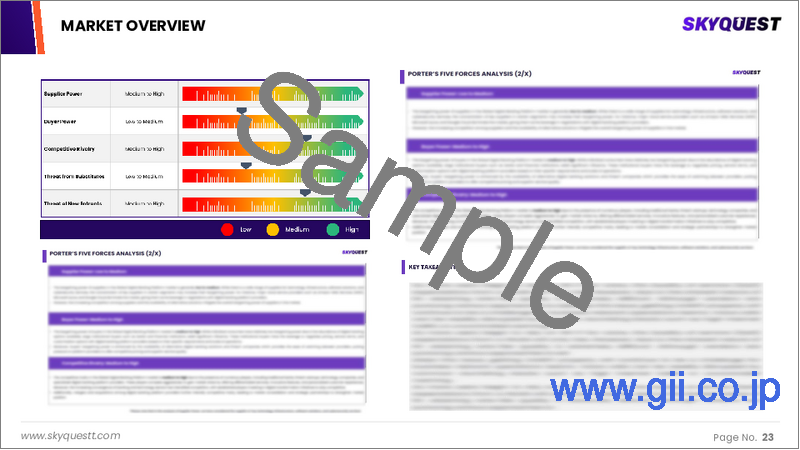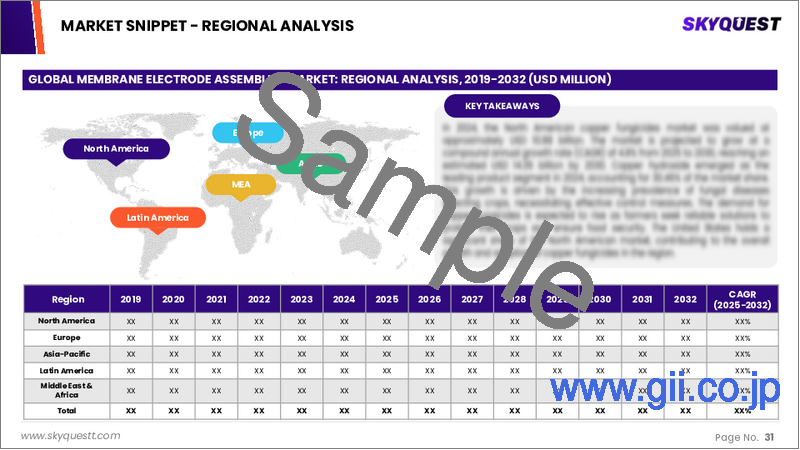|
|
市場調査レポート
商品コード
1623964
膜電極アセンブリ市場規模、シェア、成長分析、製品別、コンポーネント別、用途別、地域別-2025~2032年産業予測Membrane Electrode Assemblies Market Size, Share, Growth Analysis, By Product, By Component (Membranes, Gas Diffusion later ), By Application, By Region - Industry Forecast 2025-2032 |
||||||
|
|||||||
| 膜電極アセンブリ市場規模、シェア、成長分析、製品別、コンポーネント別、用途別、地域別-2025~2032年産業予測 |
|
出版日: 2025年01月03日
発行: SkyQuest
ページ情報: 英文 157 Pages
納期: 3~5営業日
|
全表示
- 概要
- 目次
膜電極アセンブリの世界市場規模は、2023年に6億7,200万米ドルと評価され、2024年の8億3,194万米ドルから2032年には45億9,045万米ドルに成長し、予測期間(2025~2032年)のCAGRは23.8%で成長する展望です。
膜電極接合体(MEA)は燃料電池技術にとって重要であり、電子を分離して発電する電気化学プロセスを促進します。世界企業の間でグリーン技術が重視されるようになるにつれ、特にエネルギー生産における燃料電池の需要が高まり、中東・アフリカ市場の成長に拍車をかけています。メーカー各社は、燃料電池やバッテリー駆動の電気自動車など、代替動力自動車にますます力を入れるようになっています。最近の気候変動技術への投資は急増し、記録的な高水準に達しており、市場の関心の高さを示しています。しかし、COVID-19パンデミックは産業活動全体に悪影響を及ぼし、労働力不足と工場操業停止により燃料電池と電解槽の生産が制限されています。水素燃料電池自動車セクターはパンデミック前に成長を見せたが、現在の課題はその進展を危うくしており、新たな技術進歩と生産イニシアティブの必要性を反映しています。
目次
イントロダクション
- 調査の目的
- 調査範囲
- 定義
調査手法
- 情報調達
- 二次データと一次データの方法
- 市場規模予測
- 市場の前提条件と制限
エグゼクティブサマリー
- 世界市場の展望
- 供給と需要の動向分析
- セグメント別機会分析
市場力学と展望
- 市場概要
- 市場規模
- 市場力学
- 促進要因と機会
- 抑制要因と課題
- ポーターの分析
主要市場の考察
- 重要成功要因
- 競合の程度
- 主要投資機会
- 市場エコシステム
- 市場の魅力指数(2024年)
- PESTEL分析
- マクロ経済指標
- バリューチェーン分析
- 価格分析
- ケーススタディ
- 技術の進歩
- 規制情勢
- 特許分析
膜電極アセンブリ市場規模:製品別&CAGR(2025~2032年)
- 市場概要
- 3層膜電極アセンブリ
- 5層膜電極アセンブリ
- 7層膜電極アセンブリ
膜電極アセンブリ市場規模:コンポーネント別&CAGR(2025~2032年)
- 市場概要
- 膜
- ガス拡散炉(GDL)
- ガスケット
- その他
膜電極アセンブリ市場規模:用途別&CAGR(2025~2032年)
- 市場概要
- プロトン交換膜燃料電池(PEMFC)
- 自動車
- 据置型電源
- ポータブル電源
- 直接メタノール燃料電池(DMFC)
- ポータブル電源
- 軍事
- その他
- 電解装置
- 水電気分解
- その他
- 水素燃料電池
- 自動車
- 据置型電源
- ポータブル電源
膜電極アセンブリ市場規模&CAGR(2025~2032年)
- 北米
- 米国
- カナダ
- 欧州
- ドイツ
- スペイン
- フランス
- 英国
- イタリア
- その他の欧州
- アジア太平洋
- 中国
- インド
- 日本
- 韓国
- その他のアジア太平洋
- ラテンアメリカ
- ブラジル
- その他のラテンアメリカ
- 中東・アフリカ
- GCC諸国
- 南アフリカ
- その他の中東・アフリカ
競合情報
- 上位5社の比較
- 主要企業の市場ポジショニング(2024年)
- 主要市場企業が採用した戦略
- 市場の最近の動向
- 企業の市場シェア分析(2024年)
- 主要企業の企業プロファイル
- 製品ポートフォリオ分析
- セグメント別シェア分析
- 収益の前年比比較(2022~2024年)
主要企業プロファイル
- Ballard Power Systems(カナダ)
- Plug Power Inc.(米国)
- FuelCell Energy, Inc.(米国)
- SFC Energy AG(ドイツ)
- Proton Motor Fuel Cell GmbH(ドイツ)
- Hydrogenics Corporation(カナダ)
- Johnson Matthey Plc(英国)
- W. L. Gore & Associates, Inc.(米国)
- 3M Company(米国)
- Toyota Motor Corporation(日本)
- Hyundai Motor Company(韓国)
- Panasonic Corporation(日本)
- Mitsubishi Chemical Corporation(日本)
- DuPont de Nemours, Inc.(米国)
- BASF SE(ドイツ)
- Cummins Inc.(米国)
- Advent Technologies Holdings, Inc.(米国)
- ITM Power Plc(英国)
- Nedstack Fuel Cell Technology BV(オランダ)
- ElringKlinger AG(ドイツ)
結論と推奨事項
Global Membrane Electrode Assemblies Market size was valued at USD 672.0 million in 2023 and is poised to grow from USD 831.94 million in 2024 to USD 4590.45 million by 2032, growing at a CAGR of 23.8% during the forecast period (2025-2032).
The Membrane Electrode Assembly (MEA) is crucial for fuel cell technology, facilitating the electrochemical process that separates electrons to generate electricity. As emphasis grows on green technology among global organizations, demand for fuel cells, particularly in energy production, is rising, fueling market growth for MEAs. Manufacturers are increasingly focusing on alternative power vehicles, such as fuel cell and battery-powered electric cars. Recent investments in climate technology have surged, reaching record highs, indicating strong market interest. However, the COVID-19 pandemic has negatively impacted overall industrial activities, limiting fuel cell and electrolyzer production due to workforce shortages and plant shutdowns. While the hydrogen fuel cell car sector saw growth pre-pandemic, current challenges jeopardize its progress, reflecting a need for renewed technological advancements and production initiatives.
Top-down and bottom-up approaches were used to estimate and validate the size of the Global Membrane Electrode Assemblies market and to estimate the size of various other dependent submarkets. The research methodology used to estimate the market size includes the following details: The key players in the market were identified through secondary research, and their market shares in the respective regions were determined through primary and secondary research. This entire procedure includes the study of the annual and financial reports of the top market players and extensive interviews for key insights from industry leaders such as CEOs, VPs, directors, and marketing executives. All percentage shares split, and breakdowns were determined using secondary sources and verified through Primary sources. All possible parameters that affect the markets covered in this research study have been accounted for, viewed in extensive detail, verified through primary research, and analyzed to get the final quantitative and qualitative data.
Global Membrane Electrode Assemblies Market Segmental Analysis
Global Membrane Electrode Assemblies Market is segmented by Product, Component, Application and region. Based on Product, the market is segmented into 3-Layer Membrane Electrode Assembly, 5-Layer Membrane Electrode Assembly and 7-Layer Membrane Electrode Assembly. Based on Component, the market is segmented into Membranes, Gas Diffusion later (GDL), Gaskets and Others. Based on Application, the market is segmented into Proton Exchange Membrane Fuel Cells (PEMFC), Direct Methanol Fuel Cells (DMFC), Electrolyzers and Hydrogen Fuel Cells. Based on region, the market is segmented into North America, Europe, Asia Pacific, Latin America and Middle East & Africa.
Driver of the Global Membrane Electrode Assemblies Market
The global market for Membrane Electrode Assemblies (MEAs) is significantly driven by the increasing need for efficient energy systems, particularly through the adoption of fuel cells and electrolyzers, which play a pivotal role in reducing carbon emissions. The availability of diverse resources and technologies is nearing a point that allows for substantial national contributions to fuel cell advancements. Government initiatives, such as funding collaborative research and development projects, are crucial in supporting this evolution. A notable example is Germany's National Hydrogen and Fuel Cell Technology Innovation Programme (NIP), which fosters innovation across various applications. Moreover, the automotive industry's shift towards electric and zero-emission vehicles creates new opportunities for fuel cells, as automakers invest heavily in developing advanced, efficient vehicles, further propelling the MEAs market.
Restraints in the Global Membrane Electrode Assemblies Market
The Global Membrane Electrode Assemblies (MEA) market faces significant challenges due to the critical role of MEA manufacturing in the performance of fuel cells and electrolyzers, where essential electrochemical processes occur. Manufacturing defects, such as heightened interfacial resistance between catalyst layers or fractures within these layers, can lead to accelerated stack deterioration. Additionally, the persistent issue of high costs hampers industry growth. The required humidification of MEAs negatively impacts their conductivity, resulting in increased resistance within the membrane and catalyst layers, while also causing chemical degradation. Such degradation can lead to thinning of the membrane and diminished mechanical strength, resulting in potential cell failures and reduced demand for products. Despite these challenges, ongoing research is focused on improving defect detection in fuel cell technology.
Market Trends of the Global Membrane Electrode Assemblies Market
The Global Membrane Electrode Assemblies (MEA) market is witnessing a notable upward trend as the automotive industry pivots towards more sustainable technologies, such as electric, hybrid, and fuel cell vehicles, driven by stringent international regulations aimed at reducing greenhouse gas emissions. This shift encourages manufacturers to innovate and develop eco-friendly technologies, exemplified by collaborations like the one between the Council of Scientific and Industrial Research (CSIR) and KPIT, which produced a cutting-edge LT-PEMFC fuel cell stack for automotive applications. The increasing demand for fuel cell vehicles necessitates advancements in MEA, promoting growth and diversification within the market as stakeholders invest in next-generation solutions.
Table of Contents
Introduction
- Objectives of the Study
- Scope of the Report
- Definitions
Research Methodology
- Information Procurement
- Secondary & Primary Data Methods
- Market Size Estimation
- Market Assumptions & Limitations
Executive Summary
- Global Market Outlook
- Supply & Demand Trend Analysis
- Segmental Opportunity Analysis
Market Dynamics & Outlook
- Market Overview
- Market Size
- Market Dynamics
- Drivers & Opportunities
- Restraints & Challenges
- Porters Analysis
- Competitive rivalry
- Threat of substitute
- Bargaining power of buyers
- Threat of new entrants
- Bargaining power of suppliers
Key Market Insights
- Key Success Factors
- Degree of Competition
- Top Investment Pockets
- Market Ecosystem
- Market Attractiveness Index, 2024
- PESTEL Analysis
- Macro-Economic Indicators
- Value Chain Analysis
- Pricing Analysis
- Case Studies
- Technology Advancement
- Regulatory Landscape
- Patent Analysis
Global Membrane Electrode Assemblies Market Size by Product & CAGR (2025-2032)
- Market Overview
- 3-Layer Membrane Electrode Assembly
- 5-Layer Membrane Electrode Assembly
- 7-Layer Membrane Electrode Assembly
Global Membrane Electrode Assemblies Market Size by Component & CAGR (2025-2032)
- Market Overview
- Membranes
- Gas Diffusion later (GDL)
- Gaskets
- Others
Global Membrane Electrode Assemblies Market Size by Application & CAGR (2025-2032)
- Market Overview
- Proton Exchange Membrane Fuel Cells (PEMFC)
- Automotive
- Stationary Power
- Portable Power
- Direct Methanol Fuel Cells (DMFC)
- Portable Power
- Military
- Others
- Electrolyzers
- Water Electrolysis
- Others
- Hydrogen Fuel Cells
- Automotive
- Stationary Power
- Portable Power
Global Membrane Electrode Assemblies Market Size & CAGR (2025-2032)
- North America (Product, Component, Application)
- US
- Canada
- Europe (Product, Component, Application)
- Germany
- Spain
- France
- UK
- Italy
- Rest of Europe
- Asia Pacific (Product, Component, Application)
- China
- India
- Japan
- South Korea
- Rest of Asia-Pacific
- Latin America (Product, Component, Application)
- Brazil
- Rest of Latin America
- Middle East & Africa (Product, Component, Application)
- GCC Countries
- South Africa
- Rest of Middle East & Africa
Competitive Intelligence
- Top 5 Player Comparison
- Market Positioning of Key Players, 2024
- Strategies Adopted by Key Market Players
- Recent Developments in the Market
- Company Market Share Analysis, 2024
- Company Profiles of All Key Players
- Company Details
- Product Portfolio Analysis
- Company's Segmental Share Analysis
- Revenue Y-O-Y Comparison (2022-2024)
Key Company Profiles
- Ballard Power Systems (Canada)
- Company Overview
- Business Segment Overview
- Financial Updates
- Key Developments
- Plug Power Inc. (USA)
- Company Overview
- Business Segment Overview
- Financial Updates
- Key Developments
- FuelCell Energy, Inc. (USA)
- Company Overview
- Business Segment Overview
- Financial Updates
- Key Developments
- SFC Energy AG (Germany)
- Company Overview
- Business Segment Overview
- Financial Updates
- Key Developments
- Proton Motor Fuel Cell GmbH (Germany)
- Company Overview
- Business Segment Overview
- Financial Updates
- Key Developments
- Hydrogenics Corporation (Canada)
- Company Overview
- Business Segment Overview
- Financial Updates
- Key Developments
- Johnson Matthey Plc (UK)
- Company Overview
- Business Segment Overview
- Financial Updates
- Key Developments
- W. L. Gore & Associates, Inc. (USA)
- Company Overview
- Business Segment Overview
- Financial Updates
- Key Developments
- 3M Company (USA)
- Company Overview
- Business Segment Overview
- Financial Updates
- Key Developments
- Toyota Motor Corporation (Japan)
- Company Overview
- Business Segment Overview
- Financial Updates
- Key Developments
- Hyundai Motor Company (South Korea)
- Company Overview
- Business Segment Overview
- Financial Updates
- Key Developments
- Panasonic Corporation (Japan)
- Company Overview
- Business Segment Overview
- Financial Updates
- Key Developments
- Mitsubishi Chemical Corporation (Japan)
- Company Overview
- Business Segment Overview
- Financial Updates
- Key Developments
- DuPont de Nemours, Inc. (USA)
- Company Overview
- Business Segment Overview
- Financial Updates
- Key Developments
- BASF SE (Germany)
- Company Overview
- Business Segment Overview
- Financial Updates
- Key Developments
- Cummins Inc. (USA)
- Company Overview
- Business Segment Overview
- Financial Updates
- Key Developments
- Advent Technologies Holdings, Inc. (USA)
- Company Overview
- Business Segment Overview
- Financial Updates
- Key Developments
- ITM Power Plc (UK)
- Company Overview
- Business Segment Overview
- Financial Updates
- Key Developments
- Nedstack Fuel Cell Technology BV (Netherlands)
- Company Overview
- Business Segment Overview
- Financial Updates
- Key Developments
- ElringKlinger AG (Germany)
- Company Overview
- Business Segment Overview
- Financial Updates
- Key Developments






